Brother Christian Matson, a Catholic hermit in Kentucky, recently came out as a transgender man, making him potentially the first openly transgender person in his position in the Catholic Church. Matson, who was raised in the Presbyterian Church, converted to Catholicism in 2010 and underwent his transition four years later while in college. He took vows as a hermit under Bishop John Stowe of the Diocese of Lexington in Kentucky in 2022. Matson had a message for those who criticize transgender individuals in the church, insisting that God has called them into the church and that they should not be excluded.
In light of Matson’s announcement, the Vatican’s recent document titled “Infinite Dignity” reaffirms the Catholic Church’s stance on transgender individuals. According to the document, God created individuals as biologically different men and women, and gender-affirming surgery is seen as a violation of God’s plan and an attempt to play God. Pope Francis has previously condemned gender ideology as a dangerous colonization and emphasized the importance of respecting the biological differences between men and women. Some dioceses in the U.S. have issued guidelines forbidding acknowledgment of gender transitions, while others have been more welcoming to transgender individuals.
Matson, who founded a nonprofit organization called the Catholic Artist Connection in New York City, sought to dedicate his life to his faith despite facing obstacles due to his transgender identity. After struggling to find a religious order that would accept him, he connected with Bishop Stowe, known for advocating for LGBTQ+ inclusivity. Stowe accepted Matson as a diocesan hermit because he saw Matson’s sincerity and desire to serve the church. Matson took his vows as a hermit in 2022 and continues to live a contemplative life while pursuing his art and supporting himself financially.
The Diocese of Lexington affirmed that Brother Christian has long sought to consecrate his life to Christ in the Church by living the vows of poverty, chastity, and obedience. Matson has undergone formation in the Benedictine tradition and is supported by a spiritual director. He does not seek ordination but lives a life of contemplation in a private hermitage while continuing his work in the arts. Stowe expressed relief and joy in accepting Matson into the hermitic vocation, seeing no harm in allowing him to live out his faith as a transgender man. Matson was grateful for the acceptance, feeling his hope revive and finding a sense of belonging in the church despite his unique identity.
Matson’s declaration as a transgender Catholic hermit challenges traditional views within the Catholic Church regarding gender and religious life. By openly embracing his transgender identity and making a public statement, Matson advocates for greater acceptance and inclusivity of LGBTQ+ individuals within the church. His experience highlights the importance of compassion, understanding, and respect for diversity within religious communities. As discussions around gender identity continue to evolve, individuals like Matson play a crucial role in promoting dialogue and fostering a more inclusive environment for all members of the faith community.
Despite facing challenges and discrimination, Matson remains committed to his faith and his vocation as a hermit. His journey reflects the complexities and nuances of navigating identity, spirituality, and community in the context of religious institutions. The acceptance and support he has found within the Diocese of Lexington demonstrate a growing recognition of the diversity of human experiences and the need for greater compassion and empathy within the Catholic Church. Matson’s story serves as a powerful testament to the resilience, courage, and faith of transgender individuals striving to live authentically within their religious beliefs while challenging societal norms and expectations.















